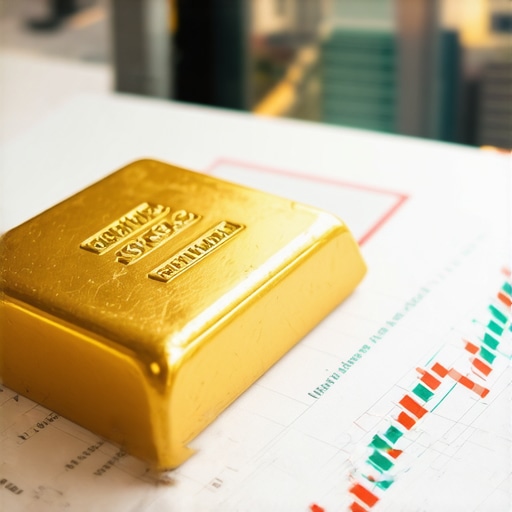Understanding Gold ETFs and Their Role in Investment Portfolios
Gold exchange-traded funds (ETFs) have emerged as a popular choice for investors looking to diversify their portfolios. They offer a convenient way to invest in gold without the need to physically buy and store the metal. In this article, we will explore how to best utilize gold ETFs for your investment portfolio, highlighting their benefits and strategic applications.
What are Gold ETFs and How Do They Work?
Gold ETFs are funds that track the price of gold and trade on stock exchanges like regular stocks. Each share of a gold ETF represents a specific amount of gold, typically held in a secure vault. This investment vehicle allows investors to gain exposure to gold prices without the complexities associated with physical gold ownership, such as storage and insurance. According to Investopedia, gold ETFs have gained traction due to their liquidity and lower expense ratios compared to mutual funds.
Benefits of Investing in Gold ETFs
Investing in gold ETFs provides several advantages:
- Liquidity: Gold ETFs can be bought and sold throughout the trading day, offering flexibility that physical gold does not.
- Cost-Effective: They typically have lower fees compared to mutual funds, making them an attractive option for investors.
- Hedge Against Inflation: Gold is often viewed as a safe haven during economic uncertainty, helping to protect your portfolio from inflationary pressures.
How to Choose the Right Gold ETF for Your Portfolio?
When selecting a gold ETF, consider the following factors:
- Expense Ratio: Look for funds with low expense ratios to maximize your returns.
- Tracking Error: Choose ETFs that closely track the price of gold to ensure you are getting the most accurate performance.
- Fund Size: Larger funds typically provide better liquidity and stability.
Strategies for Utilizing Gold ETFs in Your Investment Portfolio
To effectively incorporate gold ETFs into your investment strategy, consider the following tips:
- Diversification: Use gold ETFs to diversify your portfolio, reducing overall risk by spreading investments across different asset classes.
- Market Timing: Monitor market trends and economic indicators to make informed decisions about when to buy or sell your gold ETFs.
- Long-Term Holding: Consider holding gold ETFs for the long term to benefit from potential price appreciation and protect against market volatility.
By following these strategies, investors can enhance their portfolios and potentially increase their returns through gold ETFs. If you found this information helpful, feel free to explore more about the best gold trading techniques to further optimize your investment approaches.
Advanced Strategies for Investing in Gold ETFs
Once you’ve established the foundational knowledge of gold ETFs, it’s time to delve deeper into advanced strategies that can maximize your returns. These strategies can help you navigate the complexities of the gold market and enhance your investment outcomes.
What Are the Key Factors Influencing Gold ETF Prices?
Several factors influence the price of gold ETFs, including global economic conditions, currency strength, and interest rates. According to Wikipedia, gold prices often rise during economic uncertainty, making it essential for investors to monitor these indicators closely.
Market Analysis Techniques for Gold ETFs
Utilizing effective market analysis techniques can significantly impact your success with gold ETFs. Here are some approaches to consider:
- Technical Analysis: This involves analyzing price charts and patterns to forecast future price movements. Tools like moving averages and trend lines can provide insights into buying or selling opportunities.
- Fundamental Analysis: Evaluate macroeconomic factors such as inflation rates, geopolitical tensions, and central bank policies that could affect gold prices.
- Sentiment Analysis: Understanding market sentiment can also help. Tracking investor behavior and sentiment can provide clues about future market movements.
Utilizing Gold ETFs in a Diversified Portfolio
Gold ETFs should not exist in isolation but rather as part of a broader investment strategy. Here’s how to effectively integrate them into a diversified portfolio:
- Asset Allocation: Determine the right proportion of gold ETFs in your portfolio based on your risk tolerance and investment goals. A common approach is to allocate 5-10% of your portfolio to gold.
- Rebalancing: Regularly review and adjust your portfolio to maintain your desired allocation as market conditions change. This ensures that you remain aligned with your investment strategy.
- Complementary Investments: Consider pairing gold ETFs with other asset classes, such as stocks or bonds, to balance risk and enhance returns.
By implementing these strategies, you can optimize the performance of your gold ETFs and potentially increase your overall investment returns. If you have questions or thoughts about your own strategies, feel free to share your insights in the comments below. For further reading, check out our post on the benefits of gold as a hedge against inflation to better understand how gold can fit into your investment strategy.
Advanced Techniques for Investing in Gold ETFs
As you deepen your understanding of gold ETFs, it’s crucial to implement advanced techniques that can enhance your investment returns. These strategies go beyond basic principles and require a more nuanced approach to market analysis, portfolio management, and risk assessment.
People Also Ask: What Are the Best Practices for Managing Gold ETF Investments?
Managing your gold ETF investments effectively involves several best practices:
- Stay Informed: Regularly follow market news and updates regarding gold prices, geopolitical developments, and economic trends. Resources like Reuters offer timely insights that can help you make informed decisions.
- Utilize Stop-Loss Orders: Protect your investment by setting stop-loss orders to limit potential losses. This strategy allows you to exit a position if the price falls below a specified level.
- Monitor Correlations: Understand how gold ETFs correlate with other asset classes in your portfolio. This will help you determine the right balance between risk and return.
Understanding Gold Market Trends
To successfully invest in gold ETFs, it’s essential to keep an eye on broader market trends. Several key factors can influence gold prices:
- Global Economic Conditions: Economic slowdowns or uncertainties often drive investors towards gold as a safe-haven asset, which can increase demand and subsequently raise prices.
- Interest Rates: When interest rates are low, gold prices tend to rise as the opportunity cost of holding non-yielding assets decreases.
- Currency Fluctuations: The value of the U.S. dollar inversely affects gold prices; when the dollar weakens, gold becomes cheaper for foreign investors, boosting demand.
By understanding these trends, investors can better position themselves to buy or sell gold ETFs at the right time, maximizing potential returns.
Risk Management Strategies for Gold ETF Investors
Investing in gold ETFs, like any investment, carries risks. To mitigate these risks, consider implementing the following strategies:
- Diversification: Don’t put all your eggs in one basket. Diversify your investments across different asset classes to reduce overall risk.
- Regular Portfolio Reviews: Periodically assess your portfolio’s performance and rebalance as necessary to ensure it aligns with your investment goals and risk tolerance.
- Educate Yourself: Continuously educate yourself about the gold market, investment strategies, and economic indicators that can affect your investments. Knowledge is your best tool for risk management.
If you have any questions about managing your gold ETF investments or want to share your strategies, feel free to leave a comment below. For more insights into gold as a reliable investment, check out our article on the benefits of gold as a hedge against inflation. Bookmark this page for more updates and strategies to enhance your investment portfolio.
Utilizing Gold ETFs for Wealth Preservation
As economic uncertainties loom, investing in gold ETFs is not just a strategic choice but a compelling way to preserve wealth. Many investors turn to gold as a safe haven during market volatility, making it essential to understand how to effectively utilize gold ETFs in your portfolio. By integrating gold ETFs, you can enhance your financial resilience against inflation and economic downturns.
What Are the Best Strategies for Investing in Gold ETFs?
When it comes to maximizing your returns with gold ETFs, consider the following strategies:
- Long-Term Commitment: Adopt a long-term perspective when investing in gold ETFs. Historically, gold has shown resilience and potential for appreciation over time, making it a solid long-term investment.
- Regular Contributions: Consider dollar-cost averaging by making regular contributions to your gold ETF investments. This approach can help mitigate the impact of market volatility.
- Research and Analysis: Stay informed about market trends, geopolitical developments, and economic indicators that could impact gold prices. Resources like Bloomberg provide valuable insights into current market conditions.
Tax Considerations When Investing in Gold ETFs
Understanding the tax implications of your investments is crucial for maximizing returns. Gold ETFs are typically taxed as collectibles, which can result in higher capital gains taxes compared to other investments. It’s essential to consult with a tax advisor to navigate these complexities and optimize your tax strategy effectively.
Exploring Different Types of Gold ETFs
Various types of gold ETFs cater to different investment strategies:
- Physical Gold ETFs: These ETFs invest directly in physical gold bullion, providing exposure to the actual commodity.
- Gold Mining ETFs: These funds invest in companies involved in gold mining, offering indirect exposure to gold prices along with the potential for higher returns but also increased risk.
- Inverse Gold ETFs: For those looking to profit from declining gold prices, inverse ETFs can serve as a hedging tool.
Each type of ETF has its unique advantages and risks, making it essential to align your choice with your investment objectives.
People Also Ask: How Can I Monitor My Gold ETF Performance Effectively?
To monitor your gold ETF performance effectively:
- Use Portfolio Tracking Tools: Utilize online tools or mobile apps that provide real-time performance tracking and alerts for significant market changes.
- Review Financial News: Follow financial news outlets for updates on gold market trends and analysis, which can provide context for price movements.
- Set Performance Benchmarks: Establish benchmarks based on your investment goals to evaluate the performance of your gold ETFs against broader market indices.
By employing these monitoring strategies, you can make informed decisions regarding your gold ETF investments.
Conclusion and Call to Action
Investing in gold ETFs offers numerous benefits, including liquidity, diversification, and protection against inflation. By employing strategic approaches and understanding market dynamics, you can optimize your investment in gold ETFs for 2025 and beyond. If you’re ready to enhance your investment strategy further, explore our comprehensive guide on investing in gold for beginners and take your first steps towards a more secure financial future.
Frequently Asked Questions (FAQ)
1. What are the advantages of investing in Gold ETFs over physical gold?
Gold ETFs offer greater liquidity, lower costs, and convenience compared to physical gold. Investors can buy and sell ETFs easily on the stock market, avoiding storage and insurance costs associated with physical gold ownership.
2. How do Gold ETFs perform during economic downturns?
Gold ETFs often act as a safe haven during economic downturns. As investors flock to gold in times of uncertainty, the demand for gold generally increases, potentially boosting the value of Gold ETFs.
3. Can I include Gold ETFs in my retirement account?
Yes, many retirement accounts, including IRAs, allow investments in Gold ETFs. This can provide a hedge against inflation and market volatility within your retirement portfolio.
4. How do I know if a Gold ETF is suitable for my investment strategy?
Assess your risk tolerance, investment goals, and the ETF’s expense ratio, tracking error, and historical performance. Additionally, consider how much of your portfolio you want to allocate to gold.
5. Are there any tax implications for investing in Gold ETFs?
Yes, profits from Gold ETFs are typically taxed as collectibles, which may incur higher capital gains taxes. It’s advisable to consult with a tax professional to understand the implications for your specific situation.
6. How often should I review my Gold ETF investments?
Investors should review their Gold ETF investments at least annually, or more frequently if there are significant market developments. Regular reviews help ensure that your investments align with your overall strategy and risk tolerance.
7. What is the difference between Gold ETFs and Gold Mining ETFs?
Gold ETFs invest directly in physical gold, while Gold Mining ETFs invest in companies that mine gold. The former offers direct exposure to gold prices, while the latter can provide higher potential returns but also increased risk due to operational challenges faced by mining companies.
8. How does global economic instability affect Gold ETF prices?
Global economic instability often leads to increased demand for gold as a safe haven, resulting in higher prices for Gold ETFs. Investors typically turn to gold during crises, which enhances its value.
9. What should I consider when choosing a Gold ETF?
Consider factors such as the ETF’s expense ratio, tracking error, fund size, and the quality of the custodian holding the physical gold. Ensure that the ETF aligns with your investment objectives.
Authoritative Sources
Investopedia: A trusted resource for financial and investment information, providing insights on gold ETFs and their workings.
Bloomberg: Offers comprehensive market analysis, including trends and updates on commodities like gold, ensuring investors stay informed.
Reuters: Provides timely news and updates on global economic conditions and gold market dynamics that can affect investment decisions.
Wikipedia: Serves as a general reference for understanding gold as an investment, including its history and economic implications.
Conclusion
Investing in Gold ETFs provides a practical and strategic approach for those looking to diversify their investment portfolios. With benefits like liquidity, cost-effectiveness, and protection against inflation, Gold ETFs play a critical role in modern investment strategies. By understanding the dynamics of the gold market and employing effective investment techniques, you can optimize your returns and mitigate risks. Whether you are a seasoned investor or just starting, consider incorporating Gold ETFs into your financial strategy. If you have any questions or want to share your experiences, feel free to comment below. For more insights and strategies, explore our comprehensive guide on investing in gold for beginners and take the next step towards enhancing your investment journey.










I’ve recently started diversifying my investments with gold ETFs, and one thing that struck me was the ease of exposure to gold prices without the hassle of physical storage or security concerns. The article does a great job highlighting liquidity and cost-effectiveness, which were key factors for me. However, I’ve found that tracking the broader economic indicators mentioned—like interest rates and currency fluctuations—really helps me decide when to adjust my holdings rather than sticking strictly to a fixed allocation. Also, considering the importance of low expense ratios and minimal tracking errors, I’ve been cautious about which ETFs I choose, sometimes favoring slightly larger funds for better stability. One challenge I’ve faced is balancing the temptation to react to short-term market news versus maintaining a long-term holding strategy, which the post wisely suggests. How do others here manage that balance? Do you lean more toward active trading based on economic signals or prefer a more hands-off approach with regular reviews? I’d love to hear how different investors integrate gold ETFs into their broader portfolio strategies and handle market volatility with this asset class.
I’ve been exploring gold ETFs recently and agree that they offer a convenient way to gain exposure without the hassles of physical gold. In my experience, one aspect that’s sometimes overlooked is the importance of understanding the specific type of gold ETF you’re investing in—whether it’s physical gold, gold mining stocks, or inverse ETFs. Each has distinct risk profiles and performance drivers. For instance, gold mining ETFs can be more volatile because they’re tied not only to gold prices but also to company performance and operational costs. Have others found that diversifying among these different types helps stabilize overall returns? Also, I found the point about monitoring macroeconomic indicators crucial. Personally, I follow interest rates and currency movements closely, as they often signal underlying trends that impact gold prices. How do you balance technical analysis with fundamental insights? Integrating both seems to be the most effective strategy for me. Looking forward to hearing everyone’s approach to managing these different dynamics in their portfolios.
This post really highlights the versatility of gold ETFs as a hedge and a diversification tool in investment portfolios. I’ve personally used them to balance out stock-heavy holdings, especially during times of economic uncertainty when gold tends to perform well. However, one thing I’ve noticed is how important it is to also consider the specific type of gold ETF you choose. For example, physical gold ETFs tend to track the spot price more closely, but gold mining ETFs can be more volatile due to operational risks and company-specific factors. From your experience, do you think splitting investments between these types offers better risk management? Also, I’m curious how other investors manage the timing of their entries and exits — do you rely more on technical indicators or macroeconomic signals? I’ve found a combined approach, monitoring interest rates and currency movements alongside chart patterns, tends to work best. Would love to hear more about different strategies that help balance short-term market reactions with long-term goals!